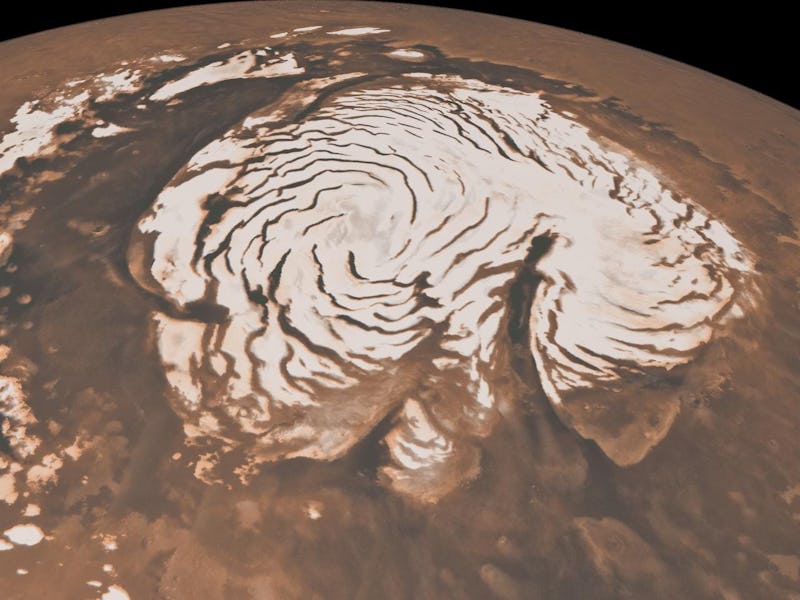Astronomers discover a salty underworld beneath the Martian surface
This increases the chances of the Red Planet's habitability.

In July, 2018, data from the European Space Agency's Mars Express found evidence of a possible salt water lake beneath the icy surface on Mars' south pole.
Two years on, and fresh evidence finds in favor of liquid water existing on the Red Planet.
The same team of scientists examined radar images of Mars collected over 10 years, and found not only evidence for one salt lake, but enough for several pools of salt water lying underneath the Martian surface.
The latest discovery is detailed in a study published Monday in the journal Nature.
The freezing surface of Mars' south pole may have preserved the salt water over the years.
After examining over 100 radar images taken by the Mars Express spacecraft from 2010 through 2019, the scientists behind the discovery found evidence of several subglacial liquid bodies of different sizes below Mars' south pole.
The largest lake stretches about 12 miles across, while the smallest one is around 3 miles, the study shows.
The average temperature on Mars is around -80 degrees Fahrenheit, way too cold to host any liquid water at the surface. But the researchers believe that these lakes maintain their liquid state due to their high concentrations of salt.
Some scientists believe Mars was once a wet, warm world, and may even have hosted life forms at some point in its early history. But over time, Mars' atmosphere was stripped away because the planet lacks a magnetic field like Earth's, making it seemingly inhospitable.
But this latest discovery suggests that some pockets of the Martian terrain may be habitable, and could contain some form of microbial life that escaped from the planet's freezing surface to its watery underworld.
Finding subglacial lakes
To find the subglacial lakes on Mars, the team behind the new study employed a method used here on Earth.
Previous research has suggested the environment beneath Mars' southern poles is quite similar to the one found in Earth's Antartica.
Scientists searching for subglacial lakes on Earth, or lakes found beneath an ice sheet, look at the smoothness of the reflection on the icy surfaces and how it varies from one spot to another. If an area happens to be brightly reflective and smooth, that suggested that a body of water flowed beneath the surface.
Using this Earthly method, researchers identified several bodies of water on Mars from the radar images, which span an area of 250 × 300 km squared.
Watery planet
The study is exciting, but scientists are wary of claiming that liquid water definitely flows beneath Mars' surface due to the planet's freezing temperatures. They are even more wary of claiming life could exist on the Red Planet at this time.
Despite that caution, Mars is our main area of focus when it comes to looking for forms of life on an object other than Earth. NASA recently sent another robotic explorer, the Perseverance rover, to search for evidence of ancient microbial life on Mars.
But if life does exist beneath Mars' surface in bodies of salty water, it would be hard for our instruments to reach. Because of the planet's climate, any life would have to exist well beneath the icy sheet of the planet's southern pole.
Ultimately, this latest study provides a new avenue in the search for life on other planets and potential pockets of habitability in the universe.
Abstract: The detection of liquid water by the Mars Advanced Radar for Subsurface and Ionosphere Sounding (MARSIS) at the base of the south polar layered deposits in Ultimi Scopuli has reinvigorated the debate about the origin and stability of liquid water under present-day Martian conditions. To establish the extent of subglacial water in this region, we acquired new data, achieving extended radar coverage over the study area. Here, we present and discuss the results obtained by a new method of analysis of the complete MARSIS dataset, based on signal processing procedures usually applied to terrestrial polar ice sheets. Our results strengthen the claim of the detection of a liquid water body at Ultimi Scopuli and indicate the presence of other wet areas nearby. We suggest that the waters are hypersaline perchlorate brines, known to form at Martian polar regions and thought to survive for an extended period of time on a geological scale at below-eutectic temperatures.
This article was originally published on